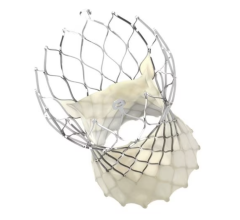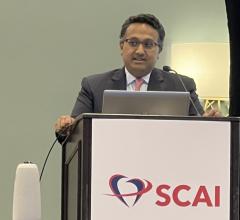
May 19, 2022 — One year outcomes from the Disrupt PAD III Trial comparing intravascular lithotripsy (IVL) with a drug-coated balloon (DCB) to percutaneous transluminal angioplasty (PTA) with a DCB was presented today as late-breaking clinical research at the Society for Cardiovascular Angiography & Interventions (SCAI) 2022 Scientific Sessions. The results revealed consistent safety and effectiveness of IVL with durable patency.
Impacting approximately 6.5 million Americans over the age of 40, peripheral arterial disease (PAD) is the narrowing of the peripheral arteries that carry blood away from the heart to other parts of the body. PAD is caused by a buildup of fatty plaque in the arteries and treatment options can including lifestyle changes, medical therapy or surgery depending on the severity of the condition. However, patients with severe calcification are often left out of clinical trials.
The Disrupt PAD III study provides the largest randomized controlled evidence to guide endovascular treatment of severely calcified superficial femoral artery-pop lesions. Looking at 45 global sites, 306 SFA-pop lesions, and, greater than 80% of lesions were defined as severely calcified by the PARC definition with an average calcified length over 125mm. The goal of the study was to assess long-term primary patency (PP) in patients treated with IVL and DCB compared to patients treated with PTA with a DCB. PP was defined as freedom from clinically driven target lesion revascularization (CD-TLR) by an independent Clinical Events Committee and freedom from restenosis determined by duplex ultrasound (DUS) as assessed by an independent core laboratory. Acute PTA failure requiring a stent during the index procedure was pre-specified per protocol as a loss of PP.
For IVL or PTA arms, PP follow-up is available in 80.4% and 83.7% of patients, respectively. Primary patency at one-year was significantly greater in the IVL arm (80.5% vs. 68.0%). The per protocol requirement for provisional stenting was significantly lower in the IVL group (4.6% vs 18.3%). Freedom from CD-TLR (IVL: 95.7% vs PTA: 98.3%) and restenosis (IVL: 90.0% vs PTA: 88.8%) were similar between the two groups at 1-year. With IVL, severe complications and the need for additional interventions are reduced compared to PTA.
“This trial offers important new insights because patients with severe PAD are often excluded from trials, resulting in a very limited amount of randomized data to guide treatment,” said William A. Gray, M.D., FSCAI, Lankenau Heart Institute/Main Line Health, Wynnewood, PA and lead author of the study. “The trial demonstrated the utility of IVL, rendering these challenging procedures safe and predictable. This offers patients future treatment pathways without the potential long-term risk of adverse clinical events such as stent fracture and restenosis.”
Researchers note continued evaluation of IVL for the treatment of calcified PAD in the ‘real-world’ setting is taking place through the Disrupt PAD III Observational Study.
Sessions Details:
“Intravascular Lithotripsy for Peripheral Artery Calcification: 1-year Outcomes from the Randomized Disrupt PAD III Trial” [May 19, 2022, 8:15 – 9:30 a.m. ET, Centennial I, Ballroom Level - LL1]
For more information: https://scai.org/scai2022
Find more SCAI22 coverage here
Related Balloon Catheter Content:
Recent Developments in Drug-Coated Balloons
VIDEO: Overview of Drug-coated Balloons — Interview with Juan F. Granada, M.D.
New Angioplasty System Dilates Calcified and Fibrotic Vessels
Balloon Catheter Comparison Chart (requires you to create login but it is free)
VIDEO: Demonstration of Intravascular Lithotripsy Breaking Up Calcium
Comparison Chart of Drug-eluting Balloons (requires login but is free to signup)
FDA Clears Coronary Intravascular Lithotripsy to Breakup Calcified Lesions With Sound Waves
VIDEO: SCAI Prospective on Key Takeaways at TCT 2019 — Interview with Chandan Devireddy, M.D., including discussion of the LEVANT study results


 February 18, 2025
February 18, 2025 








